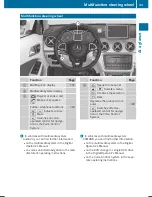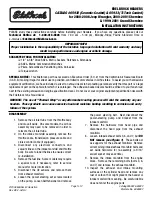
systems. Up to this height, the seat belt
cannot be worn correctly.
If a child is traveling in your vehicle, also
observe the following notes:
R
Always secure children under twelve years
of age and less than 5 ft (1.50 m) tall in suit-
able child restraint systems.
R
Child restraint systems should be installed
on the rear seats.
R
Secure a child to the front-passenger seat
only when the front-passenger front airbag
is deactivated, and then only in a rearward-
facing child restraint system. The front-
passenger front airbag is deactivated when
the PASSENGER AIR BAG OFF indicator
lamp is lit continuously (
Y
page 40).
R
Always observe the instructions and safety
notes on the "Occupant Classification Sys-
tem (OCS)" (
Y
page 47) and on "Children
in the vehicle" (
Y
page 53) in addition to
the child restraint system manufacturer's
installation and operating instructions.
Objects in the vehicle interior may restrict
the airbag from functioning correctly. To
avoid risks resulting from the speed of the air-
bag as it deploys, vehicle occupants must
ensure the following points.
Before commencing your journey, ensure that:
R
there are no people, animals or objects
between the vehicle occupants and an air-
bag
R
there are no objects between the seat, door
and B-pillar
R
there are no hard objects, e.g. coat hangers,
hanging on the grab handles or coat hooks
R
no accessories, such as cup holders, are
attached to the vehicle within the deploy-
ment area of an airbag, e.g. to doors, side
windows, rear side trim or side walls
R
no heavy, sharp-edged or fragile objects are
in the pockets of your clothing. Store such
objects in a suitable place
G
WARNING
If you modify the cover of an air bag or affix
objects such as stickers to it, the air bag
can no longer perform its intended function.
There is an increased risk of injury.
Never modify the cover of an air bag or affix
objects to it.
G
WARNING
Sensors to control the air bags are located
in the doors. Modifications or work not per-
formed correctly to the doors or door panel-
ing, as well as damaged doors, can lead to
the function of the sensors being impaired.
The air bags might therefore not function
properly anymore. Consequently, the air
bags cannot protect vehicle occupants as
they are designed to do. There is an
increased risk of injury.
Never modify the doors or parts of the
doors. Always have work on the doors or
door paneling carried out at a qualified spe-
cialist workshop.
Front air bags
!
Do not place heavy objects on the front-
passenger seat. This could cause the sys-
tem to identify the seat as being occupied.
In the event of an accident, the restraint
systems on the front-passenger side may be
triggered and have to be replaced.
Driver's air bag
:
deploys in front of the
steering wheel. Front-passenger front air
bag
;
deploys in front of and above the glove
box.
When deployed, the front air bags offer addi-
tional head and thorax protection for the occu-
pants in the front seats.
The PASSENGER AIR BAG OFF indicator lamp
informs you about the status of the front-
passenger front air bag (
Y
page 40).
The front-passenger front air bag will only
deploy if:
R
the system, based on the OCS weight sen-
sor readings, detects that the front-
Occupant safety
45
Safe
ty
Z
















































